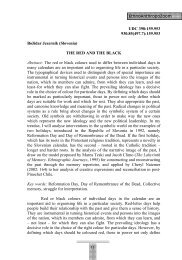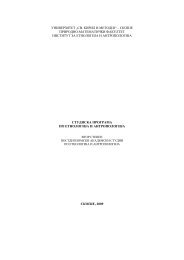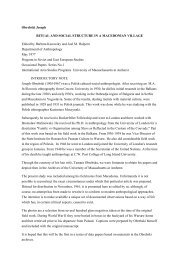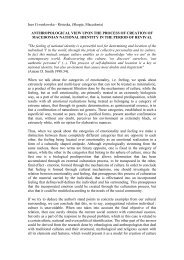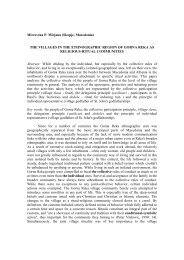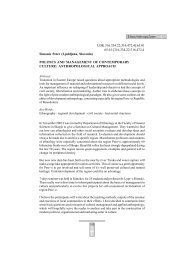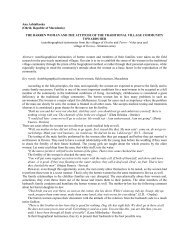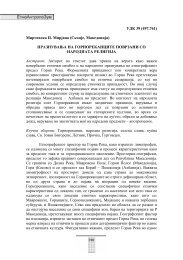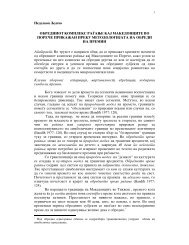Halpern M. Joel, Kerewsky-Halpern Barbara (USA)
Halpern M. Joel, Kerewsky-Halpern Barbara (USA)
Halpern M. Joel, Kerewsky-Halpern Barbara (USA)
You also want an ePaper? Increase the reach of your titles
YUMPU automatically turns print PDFs into web optimized ePapers that Google loves.
12345<br />
12345<br />
12345<br />
12345<br />
12345<br />
12345<br />
12345<br />
12345<br />
12345<br />
12345<br />
12345678901234567890123456789012123<br />
12345678901234567890123456789012123<br />
EthnoAnthropoZoom<br />
12345678901234567890123456789012123<br />
12345678901234567890123456789012123<br />
12345678901234567890123456789012123<br />
They were all most friendly in spite of our guide’s blunders. It was especially interesting<br />
to see that the zadruga system, which has just about disintegrated in Ora{ac, is still in<br />
practice here. The father lives together with his sons and their families. Each son had<br />
a room for his wife and children. (This is, of course, an over simplified evaluation of<br />
social structural changes which we have written about at length, subsequent to these<br />
observations.) Often these rooms contained nothing more than an empty dirty place<br />
with a wooden hope chest, some bundles of wool and a string a dried peppers. (We<br />
may have looked in the wrong place. We later learned not to trust quick first impressions<br />
but there is no doubt that the poverty of many of the villages we visited appeared to us<br />
much greater than we had been accustomed to in Serbia.) )Every mother had several,<br />
five to nine, children (a rather gross statement but there is no doubt that fertility rates,<br />
at that time, were higher in rural Macedonia than in Serbia, although there were<br />
significant regional and ethnic variations.) Many of them were infected and filthy.(We<br />
were tempted to insert the word “unkempt“ for “filthy“ but we have kept the original<br />
to retain the impression made on us at that time. Clearly we were encountering the<br />
extent of rural poverty prior to the economic development of the 1960s. The feeling of<br />
exoticism created by the prevalence of folk costume combined with the reality of<br />
poverty did reinforce the strong sense of “otherness“. Doubtless if we had spent a<br />
longer time among these villagers, as we had in Serbia and stayed with a prosperous<br />
household, again as we did in Serbia, we would have been less categorical in our<br />
evaluations. In this respect it is useful to refer to the observations of Jozef Obrebski<br />
which were made only a generation (20 yeas earlier) earlier. It is now fifty years, more<br />
than two generations later.)<br />
In this hilly region the land is poor and the standard crops, wheat and corn, are not<br />
cultivated near their homes. The villagers have a big hike to a lower area where there is<br />
some land. Their most important crop seems to be potatoes. Skopje is their market<br />
town. They go to market in wagons or on mule-back, the latter is a very common means<br />
of transportation in Macedonia.<br />
Our guide, instead of planning a visit to another type of village, directed the driver to<br />
a similar community. Crossing a rocky river bed again weakened the tires and, of<br />
course, we had a flat. This held us up for an hour while the driver patched the previously<br />
repaired inner tube. While this was being done <strong>Barbara</strong> picked flowers in the fields<br />
where buttercups, poppies and cornflowers grow in profusion. I walked down the road<br />
to a thatched ~uvar’s (watchman’s) hut Here a whole family from a nearby village had<br />
come by cart to spend the day working in the fields. There were eight people all<br />
together. They were having a lunch of goat’s cheese, black bread and new onions. A<br />
week-old infant slept on a pile of straw. After a half hour’s rest for lunch they all went<br />
back to their work, breaking up clods of earth with locally made hoes.<br />
When the car was ready we turned and headed in a different direction, down to the<br />
lowland area to the south of Skopje, Skopska Blatija. Here the houses were one story,<br />
mud brick plastered over with a similar material and whitewashed. In some respects<br />
they are similar to the more modest {umadijan houses. Inside all had dirt floors. One<br />
house still had an open fireplace built directly on the earth. It had a black, glistening<br />
145<br />
12345<br />
12345



